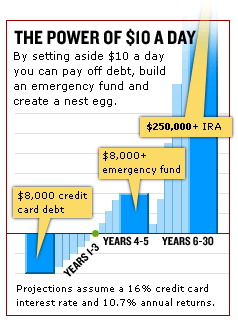
NEW YORK (MONEY Magazine) -
How would you like to be free of credit card debt? To have a financial cushion to fall back on?
To know you have the skills to save and invest for any goal -- and to guarantee your financial future? You can get there on $10 a day. If that sounds like very little -- well, it is. But it could be the key to your future.
Let's say you're the average American. You have a decent job, but you also have $8,000 in high-rate credit-card debt and no savings to speak of. You may not believe that $10 a day can dig you out of that hole. But it can-- and in less time than you think.
If you apply that $10 a day against your $8,000 credit-card debt (assuming an interest rate of 16 percent), you can pay it off in three years. Then you can put that $10 a day into a money-market account, and in another two years you'll have a fat emergency cushion -- more than $8,000.
Once you've built up your emergency fund, you can start investing your $10 a day in a tax-deferred account, like an IRA, so the money will grow more quickly. If you earn the 10.7 percent a year that the S&P 500 has returned since the 1920s, in 10 years you'll have accumulated $24,000; in 25 years, you'll have more than $250,000 -- all on $10 a day.
Of course, first you need to figure out how to free up that $10 a day.

Take your cell phone. If you're like many people, you've come to rely heavily on it. You can't imagine giving it up. Or can you? Analysts say the average cell phone bill is $53 a month. That's $636 a year. Could you give it up -- or use it substantially less often -- to help come up with your $10 a day?
How about your high-speed Internet access? Or your second car? Or that second dinner out each week?
These are hard questions. And no one can answer them for you.
But here's the good news: you may not have to cut out as much as you fear if you can free up some cash using the six relatively pain-free strategies below.
As you make your way through each of them, keep a running total of the amount you'll save.
Strategy 1: Reduce your credit card rates
Strategy 2: Refinance your mortgage
Strategy 3: Consolidate your student loans
Strategy 4: Refinance your car loan
Strategy 5: Get rid of mortgage insurance
Strategy 6: Change your withholding

|

